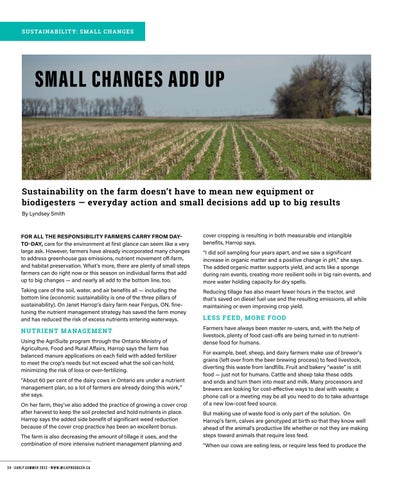S U S TA I NA B I L I T Y: S M A L L C H A N G E S
SMALL CHANGES ADD UP
Sustainability on the farm doesn’t have to mean new equipment or biodigesters — everyday action and small decisions add up to big results By Lyndsey Smith
FOR ALL THE RESPONSIBILITY FARMERS CARRY FROM DAYTO-DAY, care for the environment at first glance can seem like a very large ask. However, farmers have already incorporated many changes to address greenhouse gas emissions, nutrient movement off-farm, and habitat preservation. What’s more, there are plenty of small steps farmers can do right now or this season on individual farms that add up to big changes — and nearly all add to the bottom line, too.
cover cropping is resulting in both measurable and intangible benefits, Harrop says.
Taking care of the soil, water, and air benefits all — including the bottom line (economic sustainability is one of the three pillars of sustainability). On Janet Harrop’s dairy farm near Fergus, ON, finetuning the nutrient management strategy has saved the farm money and has reduced the risk of excess nutrients entering waterways.
Reducing tillage has also meant fewer hours in the tractor, and that’s saved on diesel fuel use and the resulting emissions, all while maintaining or even improving crop yield.
N U T R I E N T M A NAG E M E N T
Farmers have always been master re-users, and, with the help of livestock, plenty of food cast-offs are being turned in to nutrientdense food for humans.
Using the AgriSuite program through the Ontario Ministry of Agriculture, Food and Rural Affairs, Harrop says the farm has balanced manure applications on each field with added fertilizer to meet the crop’s needs but not exceed what the soil can hold, minimizing the risk of loss or over-fertilizing. “About 60 per cent of the dairy cows in Ontario are under a nutrient management plan, so a lot of farmers are already doing this work,” she says. On her farm, they’ve also added the practice of growing a cover crop after harvest to keep the soil protected and hold nutrients in place. Harrop says the added side benefit of significant weed reduction because of the cover crop practice has been an excellent bonus. The farm is also decreasing the amount of tillage it uses, and the combination of more intensive nutrient management planning and
3 4 • E A R LY S U M M E R 2 0 2 2 • W W W. M I L K P R O D U C E R . C A
“I did soil sampling four years apart, and we saw a significant increase in organic matter and a positive change in pH,” she says. The added organic matter supports yield, and acts like a sponge during rain events, creating more resilient soils in big rain events, and more water holding capacity for dry spells.
L E S S F E E D, MOR E FO OD
For example, beef, sheep, and dairy farmers make use of brewer’s grains (left over from the beer brewing process) to feed livestock, diverting this waste from landfills. Fruit and bakery “waste” is still food — just not for humans. Cattle and sheep take these odds and ends and turn them into meat and milk. Many processors and brewers are looking for cost-effective ways to deal with waste; a phone call or a meeting may be all you need to do to take advantage of a new low-cost feed source. But making use of waste food is only part of the solution. On Harrop’s farm, calves are genotyped at birth so that they know well ahead of the animal’s productive life whether or not they are making steps toward animals that require less feed. “When our cows are eating less, or require less feed to produce the




